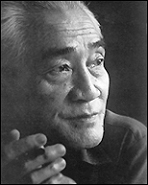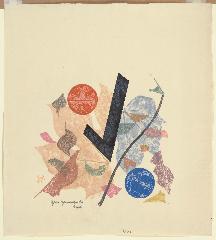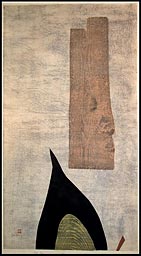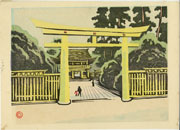Biographical Data
Biography
Yamaguchi Gen 山口源 (1896-1976)
Sources: Modern Japanese Prints 1912-1989, Lawrence Smith, British Museum Press, 1994, p. 37;
Modern Japanese Woodbock Prints: The Early Years, Helen Merritt, University of Hawaii Press, 1990, p. 251-253;
p.111Yamaguchi Gen was born in Shizuoka Prefecture in what is now Fuji City. He spent part of his youth in Tokyo and part back in Shizuoka (Shimizu City). His father was a prosperous beer and sake merchant and Yamaguchi was able to follow an artistic career throughout his life. In 1914, his parents took him to Taiwan where he met
Fujimori Shizuo (1891-1943) who interested him in printmaking. On his return to Tokyo in 1923 he was introduced to
Onchi Koshiro (1891-1955), a leader of the
sosaku hanga movement, and became his pupil. From then on he worked as a
sosaku hanga print artist, associating particularly with Onchi,
Azechi Umetaro (1902-1999) and
Maeda Masao (1904-1974) though from around 1935 he spent several years wandering on foot, mainly in Shikoku and Kyushu, possibly as an underground anti-militarist activist, before resuming printmaking in 1937 and joining Onchi’s Ichimoku-kai (First Thursday Society) in 1939. He contributed to all the Inchimoku-kai print collections and to the series
Scenes of Last Tokyo (1945) and
Picture Album of Native Customs (1946). He evacuated to Enoura (Numazu City, Shuzuoka Prefecture) in 1944 and lived there the rest of his life.
His international career began with a prize at the Ljubljana International Print Biennial in 1956 (a year after Onchi's death) and he was the first Japanese to win the Grand Prix at Lugano International Print Biennial in 1958. A Christian, a political liberal, widely read, highly independent in outlook, Yamaguchi resembled Onchi most closely of all his pupils, and his free and emotional abstraction is also close to his master’s, with a similar interest in incorporating natural and man-made objects into the printing process, such as in
Poetry of Early Autumn, pictured below.
Poetry of Early Autumn, 1947
printing with blocks of wood with addition of leaves and string |
Noh Actor, 1958 |
Yamaguchi died in 1976 in Enoura, Numazu City. His family presented 228 of his works to the City of Numazu in 1981. The Yamaguchi Gen Prize wasestablished in 1984 to recognize and encourage young artists.
Seals of the ArtistZōzōji Temple from the series










